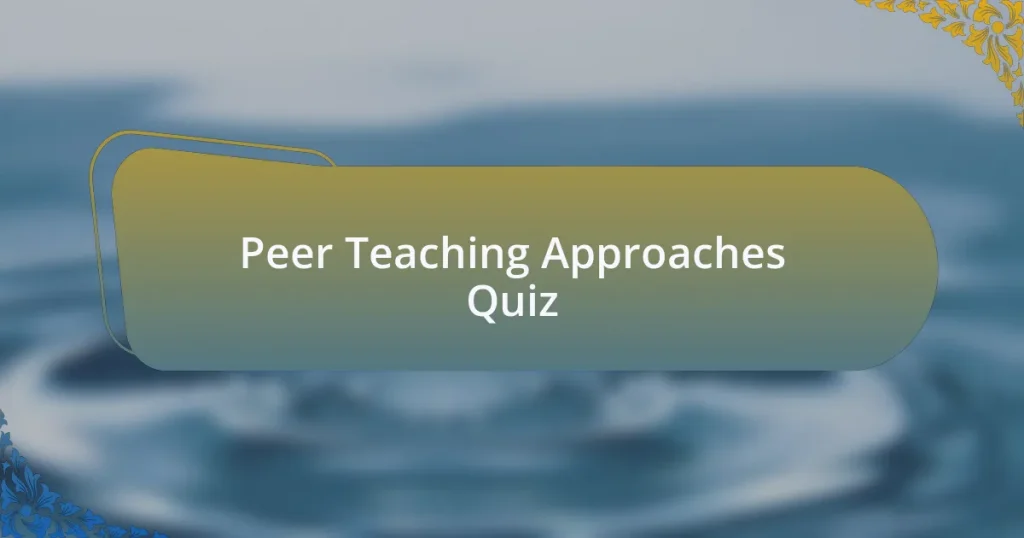Start of Peer Teaching Approaches Quiz
1. What is peer teaching?
- Peer teaching is a method where teachers evaluate students during group work.
- Peer teaching is solely about students working independently without guidance from teachers.
- Peer teaching is an educational method where students teach and learn from each other in a supervised environment.
- Peer teaching is a form of standardized testing that assesses student knowledge.
2. What are some forms of peer teaching?
- Peer tutoring
- Lecture-based teaching
- Standardized testing
- Independent research
3. What is peer tutoring?
- Peer tutoring is when teachers provide one-on-one attention to struggling students in a classroom.
- Peer tutoring is the process of evaluating each other`s tests after they have been graded by the teacher.
- Peer tutoring involves students teaching each other specific skills or content, often with one student acting as the tutor and the other as the tutee.
- Peer tutoring is a method where a teacher assigns homework for students to do alone at home.
4. What is reciprocal teaching?
- Reciprocal teaching involves students developing skills in scaffolding their peers` learning, including questioning, predicting, summarizing, and clarifying.
- Reciprocal teaching is a method where only the teacher provides instruction with no student interaction.
- Reciprocal teaching is when teachers lecture while students take notes on key points.
- Reciprocal teaching involves students listening to audio recordings and answering questions individually.
5. What is the jigsaw method in peer learning?
- The jigsaw method emphasizes competition between students to solve problems individually before sharing answers.
- The jigsaw method requires students to work independently on the same topic and then present their findings to the class.
- The jigsaw method is when students read a single text aloud together and discuss it as a whole class.
- The jigsaw method involves students being split into groups, each given a different topic to study. Then, one student from each group is taken to form a collaborative group where multiple concepts are discussed.
6. What is the proctor model in peer teaching?
- The proctor model includes students studying independently without interaction.
- The proctor model has only senior students instructing each other equally.
- The proctor model allows teachers to teach students while they study alone.
- The proctor model involves senior students tutoring junior students in a peer setting.
7. What are cascading groups in peer learning?
- Cascading groups consist of unstructured gatherings without any specific learning objectives.
- Cascading groups focus solely on competitive assessments among students.
- Cascading groups are limited to traditional lecture-based formats with no student interaction.
- Cascading groups involve placing students in groups that are either successively smaller or successively larger, allowing for specialization and support in learning.
8. What is peer support in the context of peer teaching?
- Peer support refers to a teacher providing one-on-one help to each student separately.
- Peer support is when students work alone on assignments without any collaboration.
- Peer support means students competing against each other to learn faster.
- Peer support involves students providing tips and help to one another on how to do tasks more effectively or efficiently.
9. What is the role of a mentor in peer teaching?
- A mentor in peer teaching ensures that students do not collaborate with each other.
- A mentor in peer teaching takes over the teaching duties from the students entirely.
- A mentor in peer teaching guides and supports students based on their experiences in the subject.
- A mentor in peer teaching assigns grades to students for their performance.
10. What are the benefits of peer teaching?
- Peer teaching helps students memorize information faster and more efficiently.
- Peer teaching is mainly focused on grading students and providing assessments.
- The benefits of peer teaching include improving communication skills, cultivating empathy and understanding, boosting self-confidence, and promoting student-faculty interaction and student retention.
- Peer teaching only benefits the students who are struggling in their studies.
11. What is discussion seminar in peer teaching?
- Discussion seminars are formal presentations given by instructors to students.
- Discussion seminars focus solely on written assignments without any conversation.
- Discussion seminars require students to listen passively to lectures only.
- Discussion seminars are group discussions where students engage with each other about learned topics.
12. What is the purpose of peer assessment schemes?
- Peer assessment schemes are designed solely for teachers to discuss their professional development.
- Peer assessment schemes are formal evaluations conducted by external examiners only.
- Peer assessment schemes involve students providing informal feedback to one another, such as reading each other`s essays in writing courses.
- Peer assessment schemes involve teachers grading students` work without input from peers.
13. What is the role of collaborative projects in peer teaching?
- Collaborative projects are ineffective for teaching real-world skills and teamwork.
- Collaborative projects involve students working together on tasks that serve them well for future endeavors in the workplace and society.
- Collaborative projects limit student interaction and focus solely on individual work.
- Collaborative projects create competition among students for the best results.
14. What is the significance of scaffolding in peer learning?
- Scaffolding refers to physical structures that assist in teaching complex physics experiments only.
- Scaffolding is a technique that encourages individual study without peer interaction.
- Scaffolding in peer learning involves using techniques like questioning, predicting, summarizing, and clarifying to support peers` learning.
- Scaffolding is a method for teachers to dominate the learning process and control discussions.
15. What is the difference between same-age and cross-age peer tutoring?
- Cross-age peer tutoring is exclusive to younger students only.
- Same-age peer tutoring focuses solely on high-achieving students teaching others.
- Cross-age peer tutoring means only group discussions are allowed.
- Same-age peer tutoring involves matching students of similar ages for learning.
16. What is the purpose of teach-back in peer tutoring?
- Teach-back focuses solely on assessment outcomes.
- Teach-back promotes competition among peers.
- Teach-back limits student participation in learning.
- Teach-back reinforces understanding.
17. What is classwide peer tutoring?
- Classwide peer tutoring means teachers conducting all lessons without student involvement.
- Classwide peer tutoring is when only a few students teach the entire class unilaterally.
- Classwide peer tutoring involves the entire class working in pairs to practice skills or concepts they have already been taught.
- Classwide peer tutoring refers to students working individually on different subjects without collaboration.
18. How do peer tutoring strategies benefit students?
- Peer tutoring strategies benefit students by only improving memory retention without social interaction.
- Peer tutoring strategies benefit students by extending their zone of proximal development, promoting communication skills, positive behavior, and social skills, and increasing effort in learning.
- Peer tutoring strategies benefit students mainly through individual study time without collaboration.
- Peer tutoring strategies benefit students solely by increasing competition among peers.
19. What are some challenges in implementing peer teaching approaches?
- Challenges include a lack of technology for online learning.
- Challenges include having too many students in one group.
- Challenges include providing snacks for all students during sessions.
- Some challenges include ensuring a safe and comfortable learning environment.
20. How can teachers create a safe space for peer discussions?
- Teachers can create a safe space by setting clear expectations, encouraging active listening, and fostering a respectful atmosphere.
- Teachers can create a safe space by disregarding students` opinions and prioritizing their own views.
- Teachers can create a safe space by avoiding group discussions and focusing solely on lectures.
- Teachers can create a safe space by limiting student interactions and encouraging competition.
21. What is the role of the teacher in peer teaching?
- The teacher`s role is to perform all teaching duties without student involvement.
- The teacher`s role is to eliminate all student choice in the learning process.
- The teacher`s role is to regularly grade and assess peer interactions.
- The teacher`s role is to supervise, guide, and provide support while allowing students to take ownership of their learning.
22. How does peer teaching promote student retention?
- Peer teaching has no impact on student retention and is purely for skill practice.
- Peer teaching undermines retention as students rely heavily on instructors for understanding.
- Peer teaching decreases student retention by isolating learners and limiting interaction.
- Peer teaching promotes student retention by increasing student engagement, fostering a sense of community, and providing opportunities for students to take on leadership roles.
23. What are some strategies for implementing peer teaching in the classroom?
- Strategies involve assigning grades to students and limiting their interactions.
- Strategies include focusing solely on lectures and traditional tests.
- Strategies consist of having students work independently without collaboration.
- Strategies include using the jigsaw method, reciprocal teaching, and cascading groups, as well as providing clear instructions and expectations.
24. How does peer teaching impact student self-esteem?
- Peer teaching has no effect on student self-esteem at all, as students remain focused on individual work.
- Peer teaching impacts student self-esteem positively by providing opportunities for students to help their peers, which can boost their confidence and sense of achievement.
- Peer teaching only benefits the tutor and not the tutee, leading to decreased confidence in others.
- Peer teaching negatively affects student self-esteem by creating competition among students.
25. What is the importance of peer assessment in the learning process?
- It focuses solely on grading students` work.
- It enables feedback exchange among students.
- It eliminates the need for teacher involvement.
- It discourages individual learning among students.
26. How can teachers ensure that peer teaching is effective?
- Teachers can ensure effectiveness by allowing students to teach without guidance.
- Teachers can ensure effectiveness by setting clear goals, providing necessary resources, and regularly monitoring the progress of peer teaching activities.
- Teachers can ensure effectiveness by giving all students the same role regardless of their skills.
- Teachers can ensure effectiveness by avoiding feedback on student interactions.
27. What are some common models of peer teaching?
- Study halls
- Peer support groups
- Online forums
- Lecture series
28. How does peer teaching support students in developing higher-level thinking skills?
- Peer teaching has no impact on students` thinking skills and mainly focuses on rote memorization.
- Peer teaching supports students in developing higher-level thinking skills by encouraging critical thinking, problem-solving, and collaboration.
- Peer teaching only benefits the student who is teaching and does not enhance the learning of others.
- Peer teaching restricts students to lower-level tasks and does not foster creativity or analysis.
29. What is the significance of oral communication skills in peer teaching?
- Oral communication skills are vital in peer teaching as they enhance clarity in sharing ideas.
- Oral communication skills are unimportant in peer teaching and have no impact.
- Oral communication skills are only necessary for teacher-led instruction.
- Oral communication skills hinder the learning process in peer teaching.
30. How does peer teaching promote student-faculty interaction?
- Peer teaching reduces the need for faculty involvement, leading to less student interaction with faculty.
- Peer teaching focuses solely on group work, ignoring individual interactions with faculty.
- Peer teaching fosters collaboration, encouraging students to openly interact with faculty and each other.
- Peer teaching isolates students, preventing meaningful engagement with their teachers.
Quiz Completed Successfully!
Congratulations on completing the quiz on Peer Teaching Approaches! This exercise not only tested your knowledge but also highlighted effective methods for enhancing learning in physics test preparation. You may have discovered new strategies for collaborating with peers, which can significantly boost your understanding of complex concepts. Reflection and discussion with classmates are vital components of mastering physics.
Throughout the quiz, you likely learned about various peer teaching techniques tailored for physics, such as group problem-solving and interactive tutorials. These approaches promote an active learning environment, where students can challenge each other and share different perspectives. Engaging with your peers can deepen your grasp of challenging topics like mechanics, thermodynamics, and waves.
To further expand your understanding of Peer Teaching Approaches, we invite you to check the next section on this page. Here, you will find detailed information and additional resources that can enhance your study methods. Explore how these collaborative techniques can transform your physics preparation, leading to better performance on your tests. Keep learning and working with your peers for continued success!
Peer Teaching Approaches
Understanding Peer Teaching Approaches
Peer teaching involves students teaching each other under the guidance of an instructor. This approach capitalizes on collaborative learning. It enhances understanding through discussion and explanation. Students often grasp concepts more effectively when they explain them to peers. Research indicates that peer teaching can lead to improved academic performance compared to traditional methods.
Benefits of Peer Teaching in Physics
Peer teaching in physics fosters a deeper comprehension of complex concepts, such as forces and energy. Students engage in hands-on problem-solving while teaching, reinforcing their own knowledge. This method empowers them to articulate principles clearly. Studies show that peer tutors often exhibit greater retention of material. This approach also cultivates a supportive learning environment, encouraging risk-taking and inquiry.
Strategies for Implementing Peer Teaching in Physics Test Preparation
Effective strategies include structured study groups and collaborative problem-solving sessions. Assigning specific topics or problems to each student promotes accountability. It ensures coverage of the curriculum. Incorporating peer teaching sessions prior to assessments can enhance readiness. Additionally, utilizing interactive simulations allows students to teach concepts like projectile motion through demonstration.
Challenges of Peer Teaching in Physics
While beneficial, peer teaching can face challenges. Variability in student knowledge levels can create gaps in understanding. Some students may struggle to explain concepts clearly. Additionally, group dynamics could hinder participation. It’s crucial to provide clear guidelines and monitoring to navigate these issues effectively.
Measuring the Effectiveness of Peer Teaching in Physics
Assessing the impact of peer teaching involves both qualitative and quantitative measures. Pre- and post-tests can evaluate knowledge gains. Surveys may gather student feedback on the learning experience. Observations during sessions also provide insights into engagement levels and effectiveness. These measures help instructors refine their approaches and confirm the success of peer teaching strategies.
What are peer teaching approaches in the context of physics test preparation?
Peer teaching approaches involve students teaching one another as a method of enhancing understanding and retention of physics concepts. In physics test preparation, these approaches often include collaborative activities like group problem-solving and peer-led study sessions. Educational research indicates that peer teaching can improve academic performance by up to 20%, as students often grasp difficult concepts better when explained by their peers, who may simplify complex ideas more effectively than instructors.
How does peer teaching benefit students preparing for physics tests?
Peer teaching benefits students by enhancing comprehension and fostering collaborative learning environments. Students engaged in peer teaching often report higher levels of engagement and motivation. Studies have shown that such interactions can lead to improved test scores, with participating students performing better than those who study independently, as they can clarify misunderstandings through discussion and varied perspectives.
Where can peer teaching activities take place for physics test preparation?
Peer teaching activities can occur in various environments, including classrooms, libraries, and study groups. Additionally, online platforms or discussion forums provide virtual spaces for peer-to-peer interactions, allowing for flexible collaboration. These settings facilitate easier access to resources and the ability to gather larger groups, leading to more enriched collaborative learning experiences.
When should peer teaching be implemented during physics test preparation?
Peer teaching should be implemented throughout the study period leading up to physics tests. It is especially effective when introduced after initial instruction, allowing students to consolidate their understanding before assessments. Research suggests that mid-term or pre-test collaborative sessions yield the strongest results, as they encourage revision and deeper understanding shortly before evaluations.
Who can facilitate peer teaching for physics test preparation?
Peer teaching can be facilitated by students themselves or guided by instructors. Instructors can organize and oversee peer teaching sessions to ensure structure and focus on specific topics. For successful peer teaching, students who excel in physics or demonstrate strong understanding can take on teaching roles, helping to explain concepts to classmates, thereby reinforcing their own knowledge as well.















